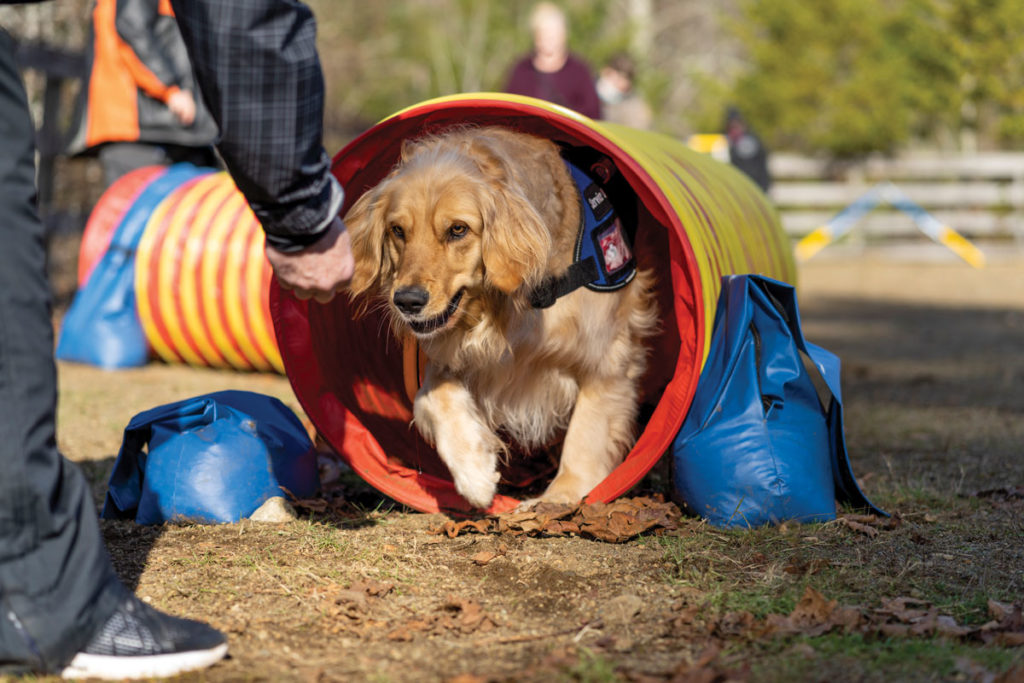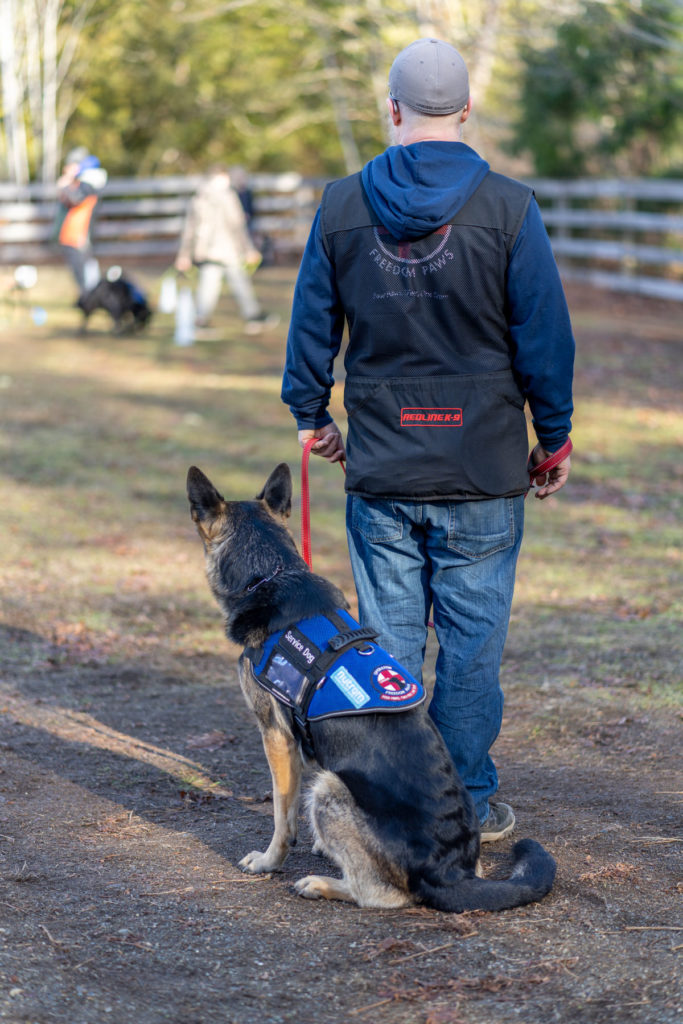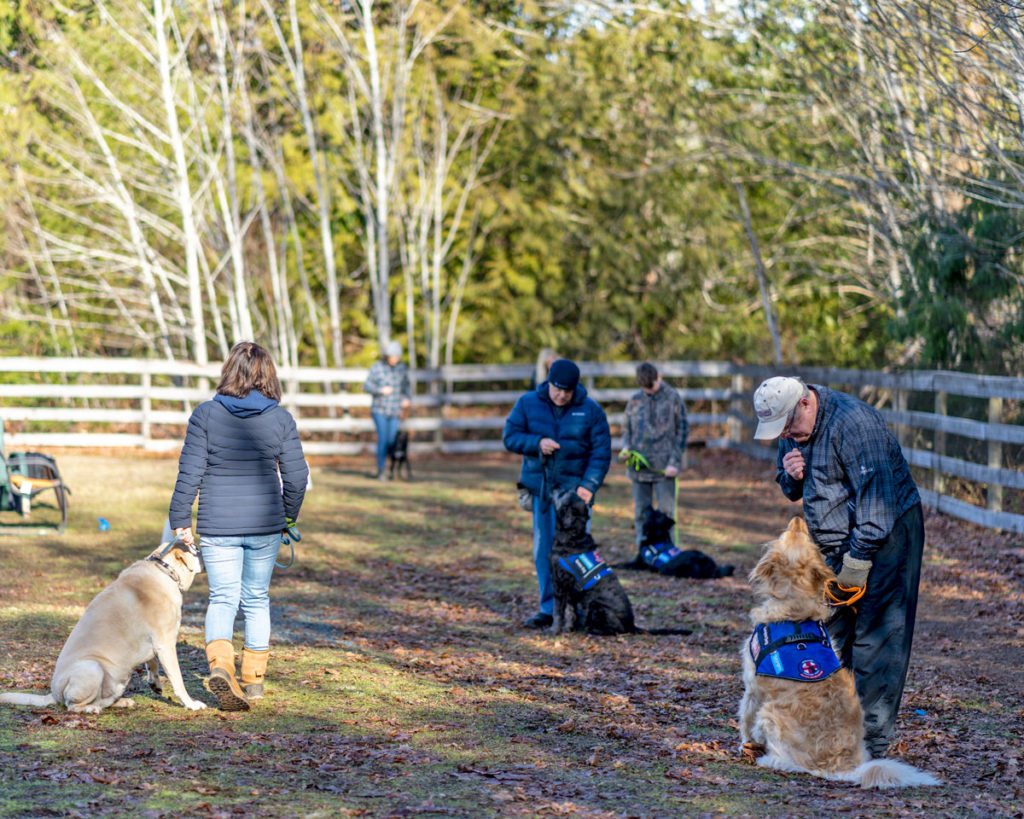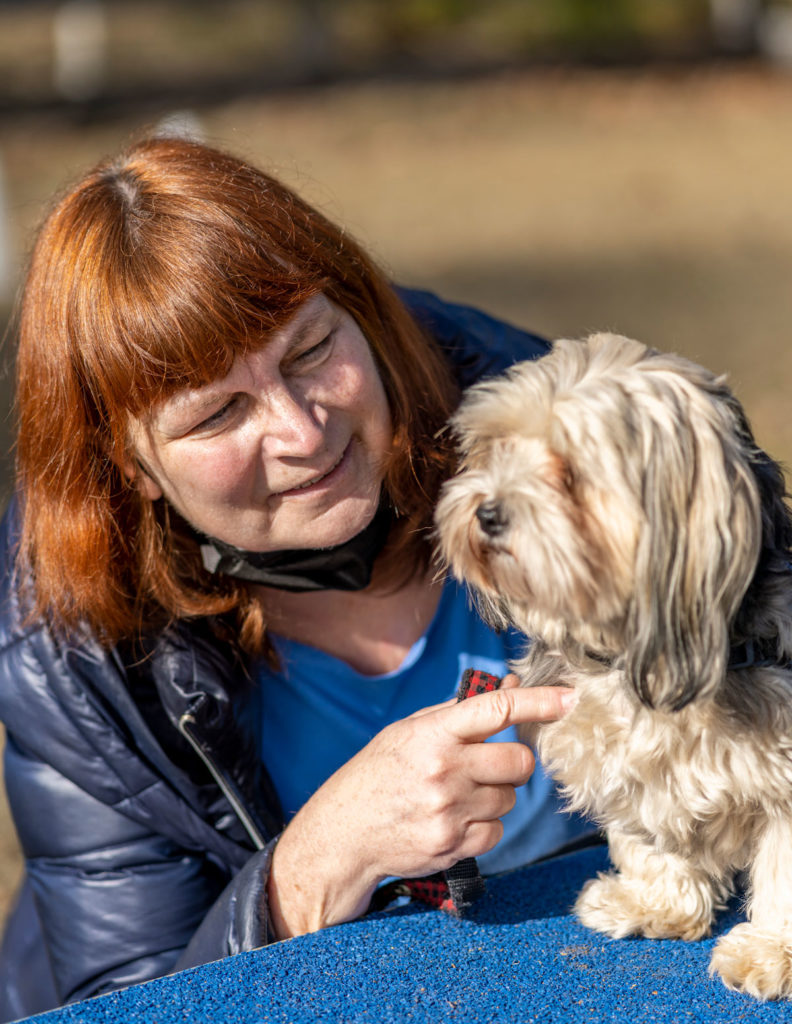Operation Freedom Paws: Dogs and people rescuing each other
By Carol Watterson. Photos by Brian Argyle
To find the training centre for Operation Freedom Paws (OFP), we needed detailed instructions — at least until we got close enough to follow the sounds of barking. Once off the highway, the laneway leading to the centre is tucked behind a set of mailboxes and marked only by a large rock. It then winds through a meadow, past a barn, and under power lines until finally revealing a large open field with a covered arena, a riding ring, small outbuildings, an RV, and most notably, a small group of people and lots of happy dogs.
For centuries, dogs have been our faithful companions, hardest workers, and even our best friends. We form strong attachments and they exemplify the role of pet companions. We often ask a lot of our canine companions and typically, without fail, they happily comply. Barb Ashmead, the founder and executive director of Operation Freedom Paws Canada, as well as co-owner of Qualicum Beach Pet Store, is also an experienced trainer who knows firsthand just how much dogs can change, and even save people’s lives.
PAIRING DOGS WITH PEOPLE
In 2013, Barb met Mary Cortani, the founder of United States-based Operation Freedom Paws in Gilroy, California. She was inspired by the meeting and the conversation stuck with her when she returned to Vancouver Island. Barb had previously co-founded Vancouver Island Compassion Dogs (VICD) and worked with veterans by pairing them with a rescue dog to create a training team. In 2019, VICD merged with BC Guide Dogs. Barb wanted to continue her mission to help individuals suffering from PTSD by matching them with a rescue dog, so she opened a Canadian branch of Operation Freedom Paws in the Spring of 2020 with Mary’s help and encouragement.
The therapeutic canine-human relationship training offered by Operation Freedom Paws empowers veterans, first responders, and people of all ages who suffer from PTSD or psychological and physical disabilities to enjoy a life of freedom. What Barb loves best about their program is that healing happens in both directions; dogs and people rescuing each other.
The only requirement for applicants is that they are dealing with trauma or a disability. While some clients bring their own dog, Barb typically matches them with a rescue. At the end of their 48 weeks of training, the dog and trainer-in-training take the Justice Institute of British Columbia’s (JIBC) Guide Dog & Service Dog Certification Testing. Candidates must pass all 40 elements in the test, but Barb is confident of their success as she won’t put anyone through unless she knows they will pass. “We people train — we train people to train their dogs — we don’t train dogs,” she explains.
NO FINANCIAL BARRIERS
Currently OFP has 23 teams in training, with the youngest client aged 11 and the eldest 73 years old. All fees are covered; from dog food (which is donated by a Canadian pet food company), adoptions fees, vet coverage, training fees, even collars and beds. Training a service dog can cost upwards of $20,000 and Barb reveals that OFP, which is a non-profit and funded purely by donations, is the only organization that does not charge a fee. She does not want there to be any financial barriers. In exchange, all she asks for is a commitment to attend at least two of the three training sessions per week. In the past two years, Barb tells us, she’s had 14 graduates with three more currently in testing. The program runs on seven-week cycles, and since participants enter at any time during the cycle, there’s always a mix of levels from beginners to the more advanced dogs and trainers. Barb likes the flexibility this gives her and her volunteers as it gives them a week of rest and recovery to recharge.
There are dogs of all sizes and breeds here today at the training center on this sunny Tuesday, and when we arrive both dogs and humans are enjoying a break. The smallest, Gracie (a little Shih Tzu), sits on her trainer’s lap next to the fire pit, while some larger dogs run through the field. Barb explains that while there’s no particular dog breed that makes a good service dog, those that are bred for hunting or tracking, like certain terriers, have character traits that are so strong they’ll likely drive the person nuts before they’re properly trained.
Barb clarifies that at OFP they train service dogs, not emotional support or therapy dogs. Trained service dogs are working dogs that are motivated to bond and attend to one person. “A service dog can smell differences in our chemistry, when we’re stressed or sick,” Barb explains. “They can smell fear or distress.” According to Barb, the primary goal is that the dog enables the person to feel safe and secure enough to go outside and manage their day-to-day lives. She explains that if you are surrounded by people, the dog will form a protective bubble, or lean against a leg to provide comfort. They can also alert their owner of an oncoming seizure or pull them out of a flashback. “Dogs can do anything,” Barb reveals. “We don’t teach them how to do something, we help them perfect a task.”
THE BEST ARE TREAT-OBSESSED
When choosing a rescue dog for the program, Barb looks for kind eyes and good body structure. It also helps if they’re food motivated. “The best dogs for training are the ones that are treat-obsessed,” she smiles. When it comes to matching a dog with a person, Barb relies on gut instinct. She explains that the first three days are the hardest, then the first three weeks, and by the third month they’ve gotten to know one another. Since these are all rescue dogs, she doesn’t know their background and how they might have suffered. For some, it could be the first time they’ve been in a house. Barb says the key is to give them a lot of support and time to allow a bond to form. “We praise them in the good times, and help them when times get rough.”
Barb has a clear strong voice that comes from years of giving concise commands to dogs and trainers. She signals that break is over with a shout. “Ok you guys, time to get back to work!” The handlers head over with their dogs to the training course where Barb guides them through a round of exercises. She starts with ‘puppy push-ups’ which involve a series of commands to wait, heel, down, up, and so on. There are plenty of encouraging, “good girl, good dog,” along with well-timed treats.
training is serious work, but there’s laughter and camaraderie too as Barb chides a couple of the older men, whom she affectionately calls ‘the Muppets’ for getting side tracked. As the group leads their dogs in a tight circle, she calls out a string of commands: “drop it” (the leash), “down” (the dog), “turn and side off” (turn left, transition back to heel). Barb offers plenty of encouragement and tips if she sees a handler or dog struggling. A service dog has to learn to be calm and quiet in public, to ignore people, other dogs and animals. According to Barb, training is not for making friends — people yes, dogs, no. She closes the session with a cheery, “Well done everybody — big praise for that!”
PUPPY YOGA
The ‘confidence course,’ with its tunnels, seesaws, barrels, and jumps, is where the dogs practice command-based acts of agility and speed. The tunnel is challenging for a few groups. Ruby, a Border Collie, needs some coaxing and the promise of a treat before mastering this task. Meanwhile, a German Shepherd tries to squeeze into the barrel rather than climb over it. After each dog completes the course at least once, Barb signals them to head over to the tent for a well-deserved ‘puppy yoga’ session.
Ellen, one of Barb’s volunteers, and her lab Tui, lead the group in puppy yoga. The purpose is for handler and dog to bond through breath, massage, and restful meditation. As Ellen begins with breathing exercises, the dogs settle into a gentle quiet. She guides them to use their sense of touch as they stroke their dog. Gentle tummy rubs elicit satisfied yawns and groans from the dogs — serenity all around. Ellen finishes with words of affirmation, “There are so many things to be grateful for, be grateful for yourself, for your dogs, be proud of yourself, and be proud of your dogs.”
Barb closes the session with exciting announcements. She and Ellen adopted six rescue dogs from Afghanistan through an international agency that will be coming to the centre the next week. She also announces that on July 16, OFP will hold a grand opening to reveal the plans for a new building on site that will include an upstairs with offices, meeting rooms, caretaker’s suite, and three bedrooms for out-of-town clients and a downstairs with kennels for dogs. The future looks bright for OFP, and as the handlers lead their dogs out of the tent, Barb sends them off with one last command, “Make sure to practices those automatic sits!”
Four paws, two feet, one team. For more information about Operation Freedom Paws Canada or to donate, visit their website at ofpcanada.org



